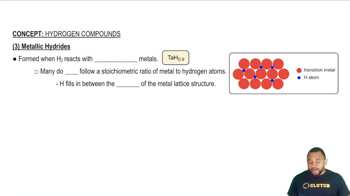Textbook Question
GeCl4 reacts with Cl- to give GeCl62-, but CCl4 does not react with excess Cl-. Explain.

 Verified step by step guidance
Verified step by step guidance



GeCl4 reacts with Cl- to give GeCl62-, but CCl4 does not react with excess Cl-. Explain.
Complete and balance the equation for each of the following reactions.
b. Ca(s) + H2O(l) →
Complete and balance the equation for each of the following reactions.
d.
Identify the group 3A element that best fits each of the following descriptions.
(c) Is extremely toxic
List three ways in which the properties of boron differ from those of the other group 3A elements.
Explain why the properties of boron differ so markedly from the properties of the other group 3A elements.